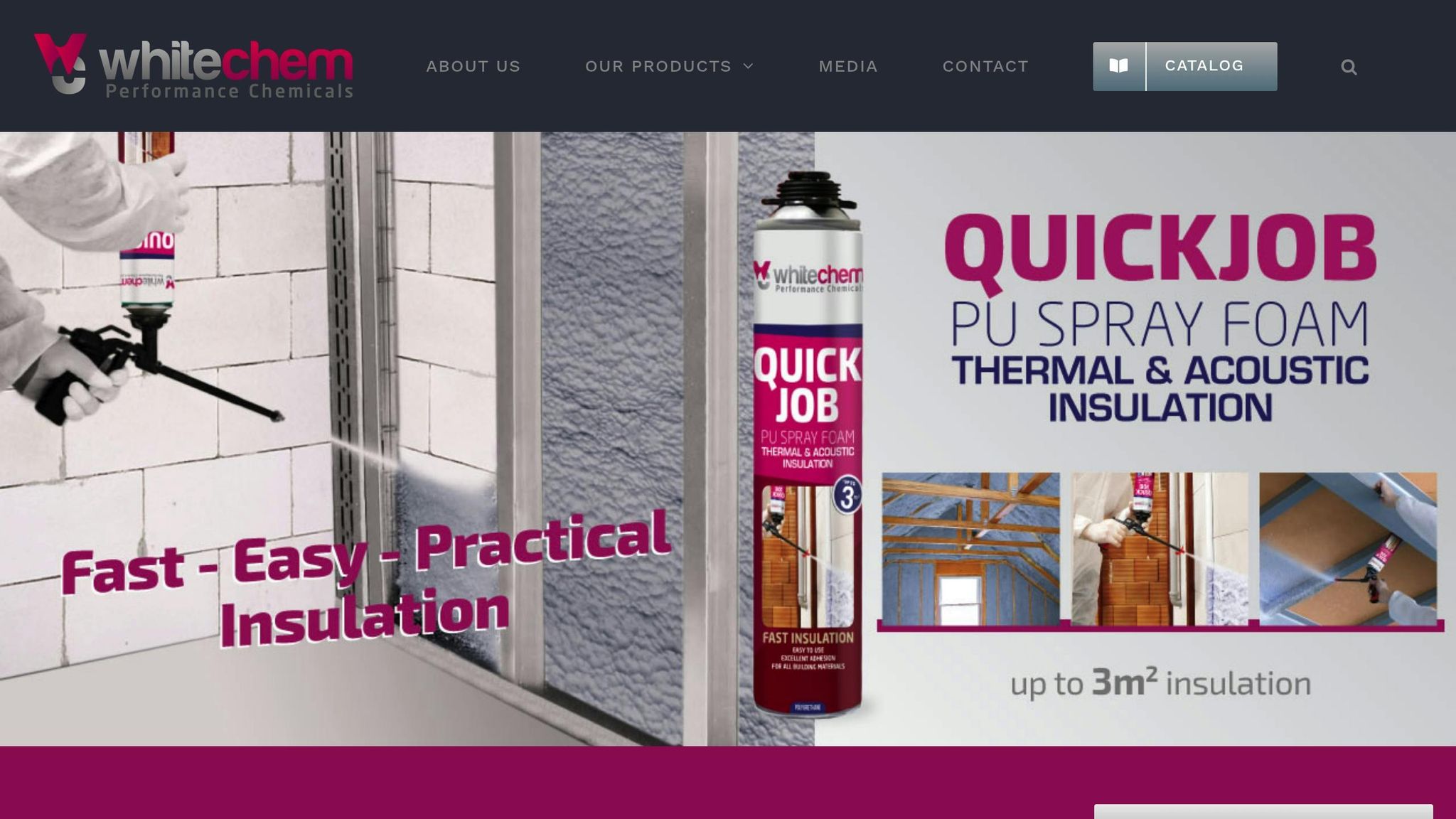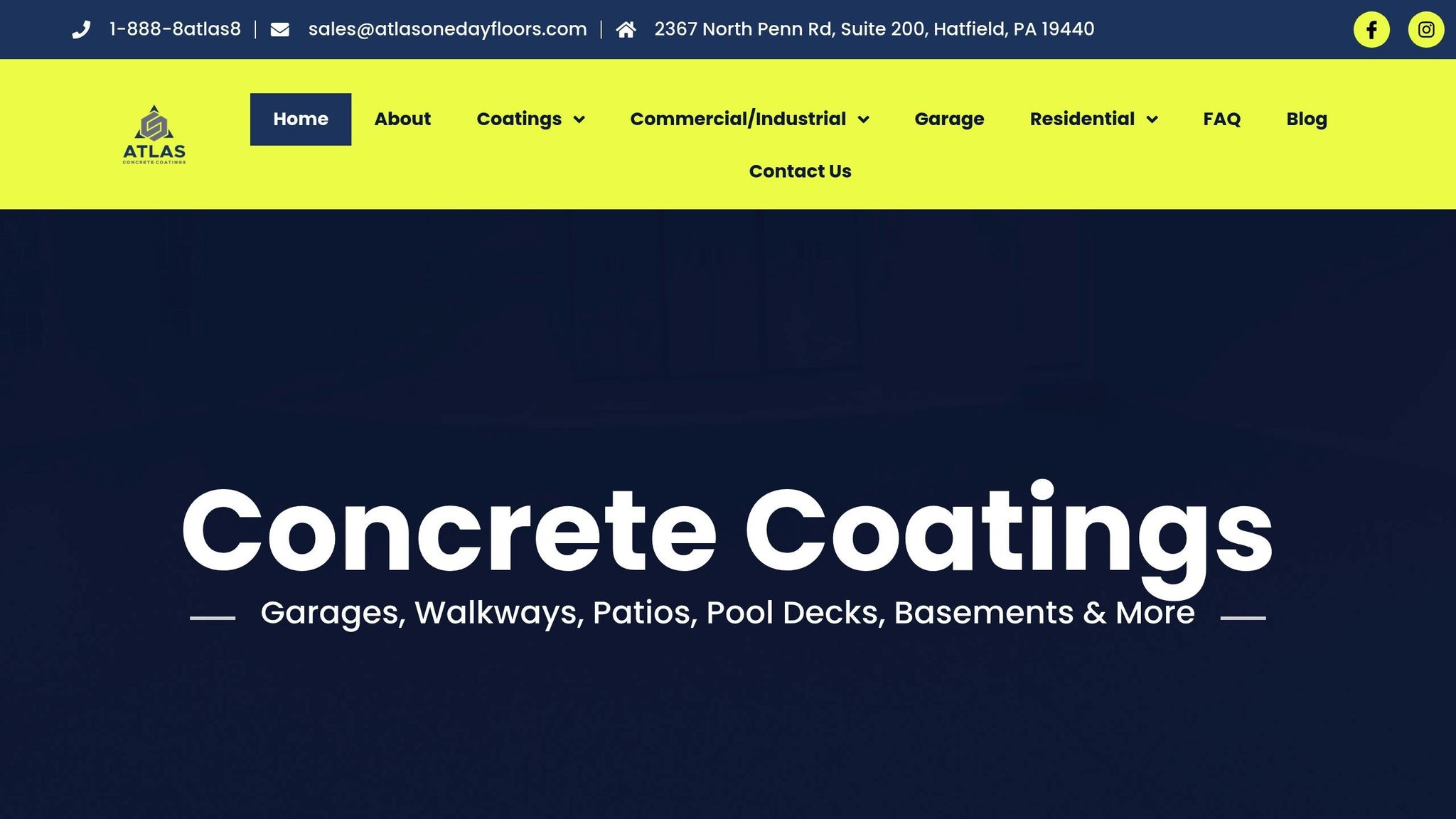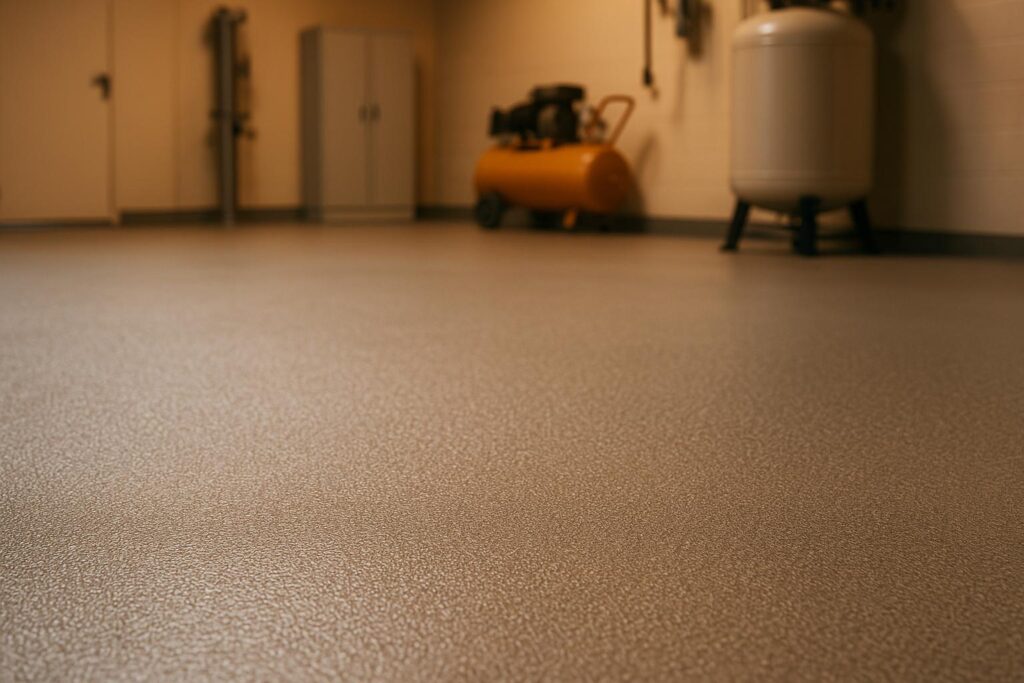Slip-resistant polyurea coatings are a durable and safe flooring solution for residential, commercial, and industrial spaces. These coatings combine toughness with textured finishes to improve traction, reducing slip risks even in wet or oily conditions. Polyurea stands out for its quick curing time, resistance to chemicals, and ability to maintain appearance under UV exposure.
Key texturing methods include:
- Chip Broadcast System: Decorative vinyl chips enhance grip and visual appeal, ideal for garages and basements.
- Quartz Aggregate Broadcast: Angular quartz particles create high-traction surfaces for kitchens or industrial areas.
- Anti-Slip Additives: Aluminum oxide or silica sand mixed into topcoats provide smoother, easy-to-clean surfaces with improved traction.
- Spray-Applied Textured Systems: Seamless application for large spaces with customizable textures.
These methods meet U.S. safety standards like ANSI A326.3-2021, ensuring slip resistance with a dynamic coefficient of friction (DCOF) of 0.42 or higher. Proper surface preparation and installation are critical for long-lasting performance, making polyurea coatings a reliable choice for slip-resistant flooring.
WHITECHEM – Slip Resistant Polyurea – SR 1080 #polyurea #waterproofing #carpark #garagefloor

Slip-Resistant Texturing Methods for Polyurea Floors
Polyurea coatings can be customized to meet both safety and aesthetic needs. Creating slip-resistant polyurea floors involves choosing the right texturing method to suit the environment and its requirements.
Chip Broadcast System
The chip broadcast system involves scattering vinyl or polymer chips onto freshly applied polyurea coatings while they’re still wet. These decorative chips not only enhance the floor’s visual appeal but also create a textured surface that improves slip resistance.
Vinyl chips typically range in size from 1/16 to 1/4 inch, with larger chips offering more pronounced texture and better slip resistance. Depending on the desired look and level of texture, the chips can be applied as full coverage (100%) or partial coverage (25-75%).
This method is especially popular for residential garages and basement floors, where moderate slip resistance is sufficient. Additionally, the chips help mask minor imperfections in the concrete substrate and stand up well to foot traffic and light vehicle use.
During the curing process, the polyurea coating encapsulates the chips, and a clear topcoat is often added to enhance durability. This top layer provides extra protection against UV rays and chemical spills, ensuring a long-lasting finish.
Quartz Aggregate Broadcast
For areas requiring a higher level of slip resistance, colored quartz aggregate is an excellent choice. These silica particles, known for their angular shape and mineral hardness, are incorporated into the polyurea base coat to create a highly textured surface.
Quartz aggregates come in various sizes, typically ranging from 16-30 mesh to 40-70 mesh. Finer mesh sizes produce a more subtle texture, ideal for spaces like offices, while coarser aggregates provide maximum traction, making them perfect for industrial settings, commercial kitchens, and automotive service areas.
The angular edges of quartz particles enhance grip by creating multiple contact points with footwear, even in wet or oily conditions. Unlike vinyl chips, quartz retains its slip-resistant properties over time because it doesn’t wear down with regular use. Its color also remains consistent throughout the life of the floor, as the pigment is embedded within the entire particle rather than being a surface coating.
Anti-Slip Additives in Topcoats
For a smoother appearance that’s still slip-resistant, aluminum oxide and silica sand can be mixed directly into polyurea topcoats. These additives create a surface that’s easy to clean while offering improved traction.
Adding aluminum oxide (2–6% by weight) significantly enhances grip, with higher concentrations providing greater slip resistance, though this may result in a slightly rougher texture. Silica-based additives are a more budget-friendly option and also improve slip resistance by forming microscopic peaks and valleys on the floor’s surface.
This method works well in retail spaces, offices, and residential areas, where safety is important but a highly textured surface would be unsuitable. The additives distribute evenly throughout the topcoat, ensuring consistent traction across the entire floor.
Spray-Applied Textured Systems
Spray-applied systems offer a seamless way to integrate slip resistance during the application process. Using single-component polyurea systems, these coatings are applied with specialized spray equipment that incorporates slip-resistant materials directly into the formulation.
These systems typically achieve DCOF values between 0.50–0.70, exceeding ANSI standards for wet surface traction. The texture can be adjusted by modifying spray pressure, tip size, and application techniques, allowing for anything from a subtle orange-peel effect to a more aggressive non-slip finish.
This method is ideal for large commercial projects and industrial facilities, where quick installation is critical. Skilled applicators can cover thousands of square feet per day, ensuring consistent texture and slip resistance throughout the space.
Spray application also allows for seamless coverage around drains, equipment bases, and floor penetrations, creating a monolithic surface that’s easier to clean and maintain while offering reliable traction in all areas.
Application Techniques and Best Practices
Getting the installation right is essential for a floor that’s both durable and slip-resistant. The key lies in proper surface preparation and following the manufacturer’s guidelines during application. These steps can mean the difference between a coating that stands the test of time and one that fails too soon.
Surface Preparation for Polyurea Coatings
Surface preparation is the backbone of a successful polyurea coating job. In fact, poor preparation is responsible for 90% of coating failures. That’s why this step is so critical.
Start by cleaning the substrate thoroughly. Use solvents and pressure washing to remove dirt, grease, and other contaminants. Mask off adjacent surfaces with plastic sheeting and painter’s tape to keep them protected during the process.
Next, address any flaking coatings, rust, or old floor treatments. Techniques like grinding, sandblasting, or mechanical sanding are effective for stripping away these imperfections. This step ensures a clean surface for the coating to adhere to properly.
To create a strong mechanical bond between the polyurea and the concrete, the surface needs the right texture. Methods such as acid etching, grinding, or light sandblasting can help achieve the necessary roughness. A properly prepared surface should feel like medium-grit sandpaper.
Before moving forward, check for moisture. Use moisture meters to confirm the substrate is completely dry, and ensure the relative humidity is below 85%. The surface temperature should be at least 5°F above the dew point. Additionally, conduct a Calcium Chloride test (ASTM F1249-13) to confirm moisture vapor emission is under 3 pounds per 1,000 square feet over 24 hours.
Step-by-Step Installation Process
Once the surface is ready, it’s time to apply the coating. Start with an epoxy primer, which improves chemical bonding and blocks any leftover moisture. After the primer has cured, apply the polyurea coating, following the manufacturer’s guidelines for mixing ratios and thickness.
Installation Conditions and Requirements
After application, maintaining the right environmental conditions is just as important as the prep work. Keep the substrate temperature at least 5°F above the dew point, and ensure the relative humidity stays below 85%. These conditions are vital for achieving the durability and safety that Atlas Concrete Coatings is known for. Always follow the manufacturer’s recommended cure times before allowing foot traffic, equipment, or vehicles on the surface.
Atlas Concrete Coatings’ team of skilled installers takes all these factors into account. Their methodical approach to surface preparation and environmental control ensures consistent, top-tier results across residential, commercial, and industrial projects.
sbb-itb-4b4bb37
Applications for Slip-Resistant Polyurea Coated Floors
Slip-resistant polyurea coatings are designed to perform exceptionally well in environments where traction is a priority. These coatings are versatile enough to be tailored for everything from busy family homes to bustling industrial facilities, with textured finishes that cater to the specific needs of each space.
Residential Uses
Homes can present a variety of slip hazards, and polyurea coatings offer a durable, safe solution for many areas. Garage floors are a prime example, as they often face exposure to oil, grease, and chemicals. Polyurea coatings provide a seamless, easy-to-clean surface that resists these substances while improving traction, especially in conditions where water, snow, or ice might be tracked inside.
Patios, decks, and pool areas also benefit greatly. Thanks to their UV stability and slip-resistant properties, polyurea coatings are ideal for outdoor spaces that frequently encounter rain, dew, or standing water. For pool decks in particular, textured polyurea surfaces ensure better grip, transforming these spaces into safer, more appealing areas – even when wet.
Basements and driveways gain from the waterproofing qualities of polyurea, which help prevent mold and mildew while improving traction. These benefits are just as valuable in residential settings as they are in larger commercial or industrial applications.
Commercial and Industrial Applications
Safety in commercial and industrial spaces often hinges on having reliable, slip-resistant flooring. Polyurea coatings are a dependable choice for high-traffic areas like retail stores, restaurant kitchens, and manufacturing facilities.
In restaurant kitchens and food prep areas, spills and grease are daily challenges. Polyurea coatings, applied seamlessly without grout lines, prevent bacteria buildup and provide textured surfaces that maintain grip, even on wet floors.
Warehouses and distribution centers, which experience heavy equipment use alongside foot traffic, benefit from polyurea’s durability. The coating’s flexibility helps prevent cracking under heavy loads while ensuring consistent slip resistance.
In manufacturing facilities, where chemical exposure is a concern, polyurea coatings shine. They protect flooring from chemical damage while their textured finish offers secure footing around machinery. Similarly, retail environments gain from polyurea’s ability to combine slip resistance with an attractive, durable surface that stands up to constant use.
Atlas Concrete Coatings‘ Services

Atlas Concrete Coatings specializes in providing durable, customizable polyurea coatings for residential, commercial, and industrial settings.
"Our products can be infused with traction-boosting finishes, and reflective gloss for enhanced brightness, and are tough enough to withstand chemicals, moisture, and several other forces that would damage your concrete if left unprotected."
The company uses a chip broadcast system, incorporating vinyl flakes into the polyurea for added durability and aesthetic appeal. This system not only enhances the look of the flooring but also ensures the slip resistance needed for safety in various environments.
Atlas Concrete Coatings serves areas in Pennsylvania, New Jersey, and Upstate South Carolina, offering coatings that are anti-slip, anti-stain, and anti-odor. Their expertise spans a range of applications, including garage floors, driveways, pool decks, patios, storage areas, showrooms, production facilities, and commercial kitchens. Each project is tailored to meet specific safety and design needs.
"Choose between our multipurpose chip systems, glossy polyurea, and other custom garage flooring blends for a stylized look with added perks. Depending on your preferences and needs, we can connect you with unique styles that offer improved surface traction, flawless moisture defense, and high impact ratings."
Founder Scott Payne emphasizes the importance of balancing functionality with aesthetics. Atlas Concrete Coatings ensures that every slip-resistant texture is customized to suit the environment while maintaining the visual appeal property owners desire.
Comparison of Slip-Resistant Texturing Methods
When deciding on a slip-resistant texturing method, it’s crucial to weigh factors like durability, slip resistance, and maintenance. Here’s a breakdown of two popular options, helping you match the method to your specific needs.
Chip broadcast systems are known for their durability, making them ideal for areas with heavy foot traffic, vehicle loads, chemical spills, oil stains, and even the occasional dropped tool. The textured vinyl flakes used in this method not only enhance grip but also come in customizable sizes – micro, standard, or jumbo – to meet specific slip resistance standards. These systems can achieve or surpass a DCOF rating of 0.42, ensuring reliable traction. Additionally, the sealed, non-porous surface simplifies cleaning – whether you’re using a mop or a hose – and resists stains, mold, bacteria, and even harsh chemicals.
Quartz aggregate broadcast systems, on the other hand, embed aggregates directly into the polyurea coating. This creates a robust, textured surface that’s both durable and permanent. While specific data on slip resistance and maintenance may vary depending on the application, this method is designed to meet stringent safety and aesthetic requirements.
Both methods align with ANSI guidelines, ensuring they consistently meet or exceed the necessary traction levels for safety.
Method Comparison Table
Here’s a quick overview of how these methods compare:
| Method | Durability | Slip Resistance | Maintenance |
|---|---|---|---|
| Chip Broadcast System | Highly durable; withstands heavy traffic, vehicle loads, spills, and impacts | Customizable textures with micro, standard, or jumbo flakes; meets DCOF 0.42 | Easy to clean; sealed surface resists stains and chemicals |
| Quartz Aggregate Broadcast | Extremely durable due to embedded aggregates | Varies by application | Varies by application |
This table highlights the strengths of each method, helping you make an informed decision based on your specific requirements.
Conclusion
Slip-resistant polyurea coatings are a practical flooring solution that combines safety, durability, and style for residential, commercial, and industrial spaces. These systems tackle safety concerns head-on while offering long-lasting performance and an appealing finish.
As discussed earlier, several texturing techniques cater to different needs. Methods like chip broadcast, quartz aggregate, anti-slip additives, and spray-applied systems each bring unique advantages. For instance, chip broadcast systems are ideal for high-traffic areas, offering customizable textures and easy upkeep. Meanwhile, quartz aggregate systems deliver a tough, embedded finish suited for more demanding environments. By integrating abrasive materials such as quartz, polymer flakes, silica sand, or aluminum oxide into polyurea coatings, these systems provide superior slip resistance compared to traditional options like epoxy.
Whether you’re dealing with a residential garage, a pool deck, a commercial kitchen, or an industrial workspace, slip-resistant polyurea coatings offer the adaptability needed to handle a wide range of safety challenges.
Atlas Concrete Coatings is equipped to elevate your flooring with industrial-grade polyurea solutions that outperform epoxy in both strength and longevity. Their detailed process – from thorough surface preparation to precise application – ensures your flooring system is built to last and perform at its best.
Choosing slip-resistant polyurea coatings is not just about safety; it’s a smart investment. These coatings can help reduce liability, cut down on maintenance expenses, and even increase property value, making them an excellent option for property owners who refuse to compromise on quality or appearance.
FAQs
What makes polyurea coatings a better choice than epoxy for slip-resistant floors?
Polyurea coatings are a top pick for slip-resistant flooring, thanks to their quick curing times – often making the surface ready for use in just a few hours. They’re also significantly stronger than epoxy, offering lasting durability even in high-traffic or industrial settings.
What sets polyurea apart is its flexibility and resistance to impact, which helps reduce the risk of chipping or peeling over time. Its elastomeric nature also boosts traction, enhancing slip resistance. This makes it a smart choice for areas where safety is key, like garages, pool decks, and commercial spaces.
How can I select the best slip-resistant texture for my polyurea-coated floor?
Choosing the best slip-resistant texture for your polyurea-coated floor comes down to the environment and how the space is used. For areas that often deal with moisture – like pool decks or commercial kitchens – textured coatings with anti-slip additives are a smart choice. They improve grip and reduce the risk of slips. In spaces with heavy foot or vehicle traffic, rougher finishes or materials like silica can add extra traction and durability.
When selecting a texture, think about factors like how much wear the surface will endure, exposure to contaminants, and the intensity of foot or vehicle traffic. Polyurea coatings are incredibly versatile, allowing you to customize the texture to meet your specific needs, all while keeping the floor durable and visually appealing.
How is a surface prepared for a polyurea coating to ensure long-lasting durability and slip resistance?
Preparing a surface for a polyurea coating requires careful attention to detail to ensure the coating adheres well and lasts over time. The first step is a thorough cleaning of the concrete to eliminate any oils, grease, dirt, or other contaminants. A clean surface is critical for creating a solid bond between the coating and the substrate.
After cleaning, mechanical preparation – such as grinding or light sandblasting – is used to achieve the proper surface texture, often referred to as the surface profile. This texture is key to helping the coating grip the concrete securely. Once the surface is adequately prepared, it’s crucial to ensure it’s completely dry before applying a primer. The primer acts as a bonding layer, providing a strong base for the polyurea coating.
For added safety, textured materials like anti-slip aggregates can be incorporated into the topcoat. This not only enhances slip resistance but also ensures the surface remains durable and visually appealing.

